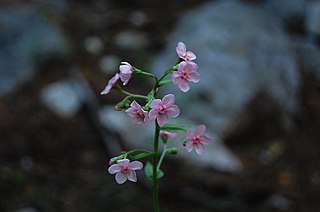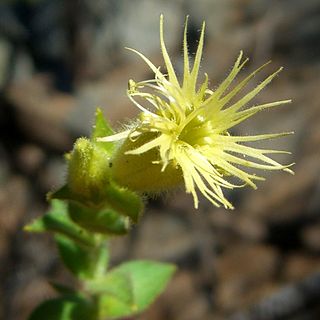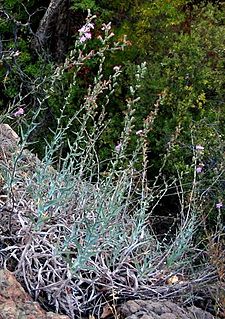
Hackelia mundula is a species of flowering plant in the borage family known by the common name pink stickseed. It is native to the high mountains of California, especially the Sierra Nevada. Its range may extend into Oregon. This is a lush, hairy perennial herb growing to maximum heights between 40 and 80 centimeters. It produces an array of erect stems with oval- or lance-shaped leaves most abundant around the bases, growing up to 22 centimeters long. The upper stems are mostly leafless and hold cyme inflorescences of flowers. Each petite flower has 5 rounded lobes which are light pink and age to light blue in color, each with a smaller petallike appendage at its base. The fruit is a small nutlet covered in thin, hairlike prickles.

Hierochloe occidentalis is a species of grass known by the common name California sweetgrass. It is a close relative of the more widely known sweet grass. It is native to the west coast of the United States from Washington to California, where it grows in the coniferous forests of the coastal mountain ranges. This is a rhizomatous perennial grass with leaves up to 30 centimeters long and 1.5 wide. The stem reaches a meter in height with an inflorescence of 7 to 10 centimeters. The spikelets grow on short, wavy stalks and each has three florets with long, protruding stamens during flowering.
Enemion stipitatum is a species of flowering plant in the buttercup family known by the common name Siskiyou false rue anemone. It is native to northern California and southern Oregon where it grows in forest, woodland, and chaparral habitats in the local mountain ranges. This is a petite perennial herb producing one or more erect, unbranched stems to a maximum height no more than 15 centimeters. Leaves appear toward the top of each stem in arrays of several cloverlike leaves with three-lobed leaflets. The tiny solitary flowers each have five white petallike sepals only a few millimeters long. The center of the flower contains several thick white stamens topped with small yellow anthers and 3 to 5 styles.

Collinsia callosa is a species of flowering plant in the plantain family known by the common name desert mountain blue-eyed Mary. It is endemic to California, where it grows in the mountains of the southernmost Sierra Nevada, the Transverse Ranges, and the mountains of the Mojave Desert region. It grows in desert scrub, chaparral, and woodland habitat on the mountain slopes.

Eriogonum luteolum is a species of wild buckwheat known by the common name goldencarpet buckwheat. It is native to many of the mountain ranges of California and southern Oregon, including the Sierra Nevada, Cascades and California Coast Ranges. It grows in mountain and foothill habitat, such as forest and woodland, on granite and sometimes serpentine soils.

Lewisia cantelovii is an uncommon species of flowering plant in the family Montiaceae known by the common name Cantelow's lewisia. It is endemic to California, where it is known from the northeastern mountain ranges from the Klamath Mountains to the northern Sierra Nevada. It grows in rocky, moist mountain habitat. This is a perennial herb growing from a short, thick taproot and caudex unit. It produces a basal rosette of thick, fleshy, blunt-tipped spoon-shaped leaves with serrated edges. The inflorescence is a very slender erect stem up to 45 centimeters tall topped with a spreading panicle of flowers and glandular, toothed bracts. Each flower has 5 to 7 oval petals each one half to one centimeter long. The petals are white or very pale pink with sharp dark pink veins. At the center of the flower are five stamens tipped with dark pink anthers.
Lithophragma heterophyllum is a species of flowering plant in the saxifrage family known by the common name hillside woodland star. It is native to the coastal mountain ranges of California, where it can generally be found in shady habitat. It is a rhizomatous perennial herb growing erect or leaning with a slender naked flowering stem. The leaves are located on the lower part of the stem, each divided into rounded lobes. The stem bears 3 to 12 flowers, each in a cuplike calyx of red or green sepals. The five petals are white, up to 1.2 centimeters long, and usually divided into about three pointed lobes.

Minuartia stolonifera is a rare species of flowering plant in the pink family known by the common names Scott Mountain sandwort and stolon sandwort.
Monardella australis is a species of flowering plant in the mint family, known by the common name southern monardella.
Muilla transmontana is a species of flowering plant known by the common name Inland muilla. It is native to sections of the Great Basin in Nevada and in California east of the major mountain ranges. It grows in mountain forest and scrubby high desert and plateau habitat.

Polemonium chartaceum is a rare species of flowering plant in the phlox family known by the common names Mason's Jacob's-ladder and Mason's sky pilot. It is native to California, where it has a disjunct distribution. It occurs in the Klamath Mountains as well as the ranges east of the Sierra Nevada, including the White Mountains, where its distribution extends just into Nevada. It is a plant of high elevations, growing in exposed, rocky mountain slope habitat such as talus and alpine fellfields.

Silene parishii is a species of flowering plant in the family Caryophyllaceae known by the common name Parish's catchfly. It is endemic to southern California, where it is known from several of the local mountain ranges, including the San Bernardino, San Gabriel, and San Jacinto Mountains. It grows in rocky, forested habitat, sometimes in the alpine climates of the higher peaks. It is a perennial herb growing from a woody, branching caudex and taproot, sending up several decumbent or erect stems 10 to 40 centimetres tall. The oppositely arranged leaves line the stems, the largest ones located at the middle of each stem. Leaves are lance-shaped to nearly oval and up to 6 centimetres long. They are thick and leathery, and sometimes glandular and sticky. Each flower is encapsulated in a tubular calyx of fused sepals which may be nearly 3 centimetres long. It is greenish with ten veins and a coating of glandular hairs. The five petals are yellowish in colour and each has about six long, fringelike lobes at the tip.

Silene sargentii is a species of flowering plant in the family Caryophyllaceae known by the common name Sargent's catchfly. It is native to the western United States, where it is known from the mountain ranges straddling the California-Nevada border east of the Sierra Nevada. It is also known from one disjunct occurrence in central Washington. It grows in rocky mountain habitat in subalpine and alpine climates. It is a perennial herb growing from a woody, branching caudex and taproot, sending up several decumbent or erect stems and shoots. It grows no more than about 20 centimeters tall, often taking a clumpy form. The fleshy leaves are widely lance-shaped and a few centimeters in length, most of them occurring around the caudex. Each flower is encapsulated in a hairy, glandular calyx of fused sepals which has stark purple veining. The petals are white to deep pink and each has two or more rounded or pointed lobes at the tip.

Stephanomeria cichoriacea is a species of flowering plant in the aster family; it is known by the common names chicoryleaf wirelettuce and silver rock-lettuce. It is endemic to California, where it grows in the coastal mountain ranges as far north as Monterey County, but especially in southern California mountains such as the Transverse Ranges. Its habitat includes chaparral. It is a perennial herb producing slender erect stems reaching maximum heights exceeding one meter. The stem is woolly with hairs, especially on new growth. The leaves are mostly located in a basal rosette, the largest reaching 18 to 20 centimeters long. They are lance-shaped and often toothed along the edges, and the newer ones are woolly. Smaller leaves occur farther up the stem. The inflorescence is a long array of several flower heads, with some occurring in the upper leaf axils as well. Each head has a cylindrical base 1 to 2 centimeters long which is lined with layers of glandular phyllaries. The head contains 10 to 15 ray florets, each with an elongated tube and a pink ligule which may be up to 2 centimeters long. The fruit is an achene tipped with a spreading cluster of long, plumelike pappus bristles.
Streptanthus bernardinus is a species of flowering plant in the mustard family known by the common name Laguna Mountains jewelflower, or Laguna Mountain jewelflower.
Boechera yorkii is a rare species of flowering plant in the mustard family known by the common name Last Chance rockcress. It is endemic to Inyo County, California, where it is known only from the Last Chance Range in Death Valley National Park. There are only two occurrences known, but the plant occurs in remote, nearly inaccessible mountain territory, so more plants may exist unobserved. The species was only described to science in 2004. Its habitat is rocky mountain canyons on cliffs of dolomite.

Vexatorella obtusata is an evergreen shrub, with narrow, leathery leaves and about 2 cm big, globular flowerheads consisting of well scented, creamy pink flowers, from which a long style with a thickened tip extends. Two subspecies are distinguished, both restricted to different parts of the Western Cape province of South Africa. The creeping V. obtusata subsp. obtusata, also known as the Montagu vexator flowers from September to December, and the upright V. obtusata subsp. albomontana, also known as the Witteberg vexator, that has flowers between August and November.
Protea intonsa, also known as the tufted sugarbush, is a flowering plant of the genus Protea within the family Proteaceae, endemic to South Africa, where it is distributed from the eastern Swartberg and Kammanassie Mountains to the Baviaanskloof mountains. In Afrikaans it is known as klossie-suikerbos.
Protea vogtsiae, also known as the Kouga sugarbush, is a small flowering shrub of the genus Protea within the family Proteaceae, which is only found growing in the wild in the southern Cape Region of South Africa.
Protea laevis, also known as the smooth-leaf sugarbush, is a flowering shrub that belongs within the genus Protea.










